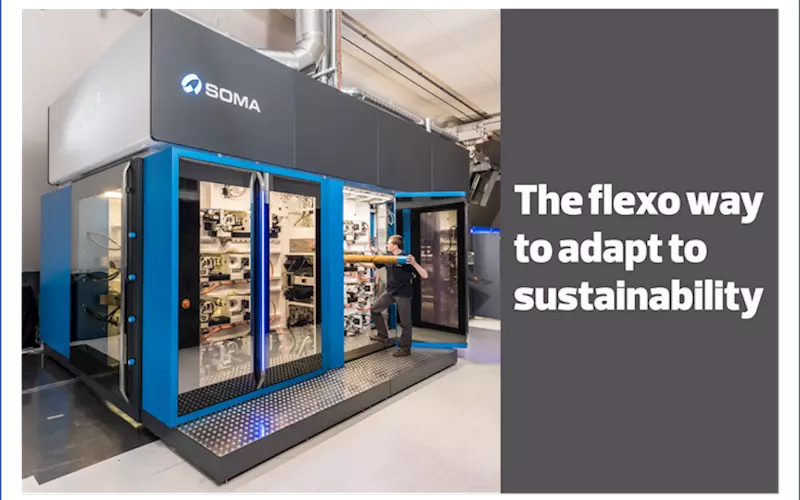The flexo way to adapt to sustainability - The Noel D'Cunha Sunday Column
Sustainability of the planet will continue to be a significant issue for printers and converters; not only because brands require it, but also because it is the right thing to do.
In this Sunday Column, Suhas Kulkarni of Soma explains how the company’s new kit Optima2 can help converters and brands to overcome sustainability challenges
17 Dec 2023 | By Noel D'Cunha
There are many objectives to tackle sustainability in packaging – less waste, less ink, less energy, and less CO2 expended. For brands, this goes far beyond printing; for example, into transportation, consumables and packaging recycling… What has been Soma’s approach?
We all know energy has become a crucial commodity (one need not look farther than Europe). This puts pressure on the manufacturers of the substrates and inks as well as SOMA, who must make them print well on press. To that end, Soma is doing all we can to handle all environment-friendly technologies such as water-based printing, paper or biodegradable materials printing, ECG or energy-cured inks (UV).
Do you mean innovation in substrates?
Packagers and, more importantly, brand owners are always looking for new materials that are easier to work with and substrates and inks that are safe—for food products, in particular. There is an influx of new materials that ensure packaging is fully recyclable or reduces the carbon footprint while not impacting product quality or the appearance of the packaging.
What about barrier coatings?
Yes, there is also an effort to offer various barrier coatings to replace laminates, applied on the press, a downstream unit, or a separate station. Therefore Soma launched a new portfolio of such stations called IPU – Intelligent Printing Units. From a basic brand’s interests, it complies easily with food safety standards while allowing 100% recyclability of the packaging. Manufacturers of these new substrates are trying hard to ensure that anything they develop can be fully useable on current packaging equipment.
Soma is an equipment manufacturer. What has been the approach?
There has become a two-pronged approach from Soma. One is to ensure successful ways to print attractive graphics on difficult substrates. The other is to offer ways that the operation of the Optima2 press puts less strain on waste and energy requirements.
With new substrates and a trend away from harmful materials, there is a movement away from solvent-based inks, with many more preparations of water-based inks. In its 2022 report, The Future of Water-based vs Solvent Printing to 2027, Smithers projected aqueous inks to grow 5.6% annually through 2027, compared to solvent ink growth of +1.3%.
Another sustainable solution is UV ink. It is a volatile organic compound (VOC) emission-free process, with no ozone extraction required, resulting in reduced infrastructure exhaust systems, air exchange and power delivery. Moreover, UV ink makes design graphics pop out from the package. Greater ink pigmentation also means less ink volume is required. Optima presses can print both UV mercury or UV LED inks
How do you ensure the heating systems are effective?
For solvent and water-based inks, one way to ensure that slow-drying inks are dried as efficiently and as fast as possible is to create ‘intelligent drying’. If you can create an almost closed-loop drying system, you can dry inks efficiently. When it reaches the defined LEL level (solvent saturation in the exhaust), the system will output a minimum amount of air (and energy) needed to drop the LEL level to a defined level. Improved solution is another key factor.
Is the Optima2 press equipped with modules to achieve energy saving?
Soma has achieved this with our i-Dry intuitive drying setting for optimal energy savings. The software upgrade can set the press to different drying performance levels for individual machine modes.
What does i-Dry do?
Some i-Dry is an extremely efficient system for stand-by modes, low speeds, or printing designs with low ink coverage. The effective system can automatically adjust the speed of ventilators and/or keep them on a minimum level during standby mode. The three-fan drying system consisting of a between-deck drying loop and drying tunnel loop helps to dry ink quickly. It can also deliver exceptional energy savings if heat recuperation from regenerative thermal oxidizers (RTOs) is integrated. The burned fumes energy is recovered and used to preheat the air drying systems in the press.

Suhas Kulkarni of Soma
Let’s talk about extended colour gamut (ECG) printing vis-à-vis sustainability?
ECG printing has become a hot topic. When it comes to expanded colour gamut economics, the resulting environmental impact is just as important as the aesthetic advantages.
By avoiding the ink changes between runs, a printer can reduce wasted ink and washing detergents. This results in a more ecological package printing process with more run time, less set-up time, less cleaning, and less waste. Ink inventories are reduced because there is less need to store expensive spot colours. It also means no anilox change, reduced usage of solvents for washing the press, and the ability to print multiple jobs on the same run. Furthermore, gang-run printing allows high flexibility to print short jobs more ecologically and efficiently.
Any examples of Soma working on ECG printing projects?
Soma continues to explore ways to make ECG printing as efficient as possible. For example, in the past, we collaborated with the Flint Group and Marvaco to work on eco-friendly full HD ECG printing on BOPP film. During the numerous webinars Soma has conducted, we have demonstrated ways to reduce the use of inks, minimise flexo plate consumption, save waste and totally eliminate ink washes during job changes.
We can’t forget colour management for conventional CMYK + spot colour printing…
Certainly not. A good colour management and/or matching solution will allow printers to reduce makereadies by as much as 25%, increasing capacity, saving ink, and reducing waste. Minimum waste during press make-ready is the ultimate goal.
Does Optima2 press have an automatic make-ready solution?
The Soma IRIS (intelligent register and impression setting) system offers printers a powerful solution for short runs. The systém measures data used for make-readies on the press, during the plate mounting procedure. When a sleeve is inserted into a flexo press, registration and topography/impression data are read from an RFID chip and prepared for fully automatic operation. It helps to assure that every job is automatically in registration and impression quickly. This reduces makeready time and assures faster completion of jobs—along with almost zero-meter set-up waste—a flexible, agile, and sustainable solution for short runs.
There are many more features that every press manufacturer can offer to make a company more sustainable. What improvements has Soma made to the Optima2 press?
Soma’s press monitoring system can have as much influence as any mechanical improvement. The advanced, modern press monitoring system can allow supervision and long-term monitoring of flexographic press efficiency and energy consumption via the internet, from the office or anywhere in the world.
Energy recovery is equally critical?
Soma uses drives—some of which can include electricity retrieval— which can reduce the amount of power required to operate the press. With a recuperation system, the kinetic energy—the total random moving energy—can converted into useful electrical energy. The savings are measurable and helpful.
What does the Optima2’s gas/electric hybrid drying system do?
The Soma Optima2 includes a system where the operator can make a decision based on gas or electric energy costs at any given time. While they run separately, both systems are installed, and the operator chooses the panel which operates during printing.
The Soma ink cartridge system another interesting addition...
Yes. Certain inks, particularly expensive spot colours, special effects and metallic formulations, can be costly—and it is always a shame to waste any ink. On average, about five to seven litres of ink are in the press system in one deck (doctor blade chamber, pump, and hose). When a print job is finished, this ink is returned to a bucket, yet some percentage of the ink is always lost on its way back due to cleaning or residue. The Soma ink cartridge system can reduce ink volumes and residual waste. With the Soma ink cartridge system, the volume of ink is significantly reduced by a short connection directly to the chamber.
So, going ahead, what should we expect? What could happen in the future?
A greater environmental approach in packaging is guaranteed. If we speak plastics, one option is bio-renewable packaging. The second option is 100% recyclable packaging. It seems that the path is not defined yet, as both technologies have their pros and cons. Yet, surely, there will be new printing challenges associated with these. And so we will ensure that Optima2 presses with newly developed IPUs – Intelligent Printing Units, can handle these challenges
A good flexo press is still the heart of a print facility. Why do you think the Optima2 is a perfect fit? What is your advice?
The Soma Optima2 can be improved to save inks and substrates, print exquisite graphics with sustainable materials, and be energy efficient is advantageous. It makes a company more attractive to a brand owner, safer for its employees, and more cost-effective. And most important, it provides the company with an ethical standing on this earth.
My advice: Pay attention to what your flexo press can do.
Finally, when are we going to see the Optima2 press in India?
I fully agree that Indian market deserves such advanced technology as Optima2 printing press and can only comment that the Soma team is working hard to make this happen in the near future.











 See All
See All